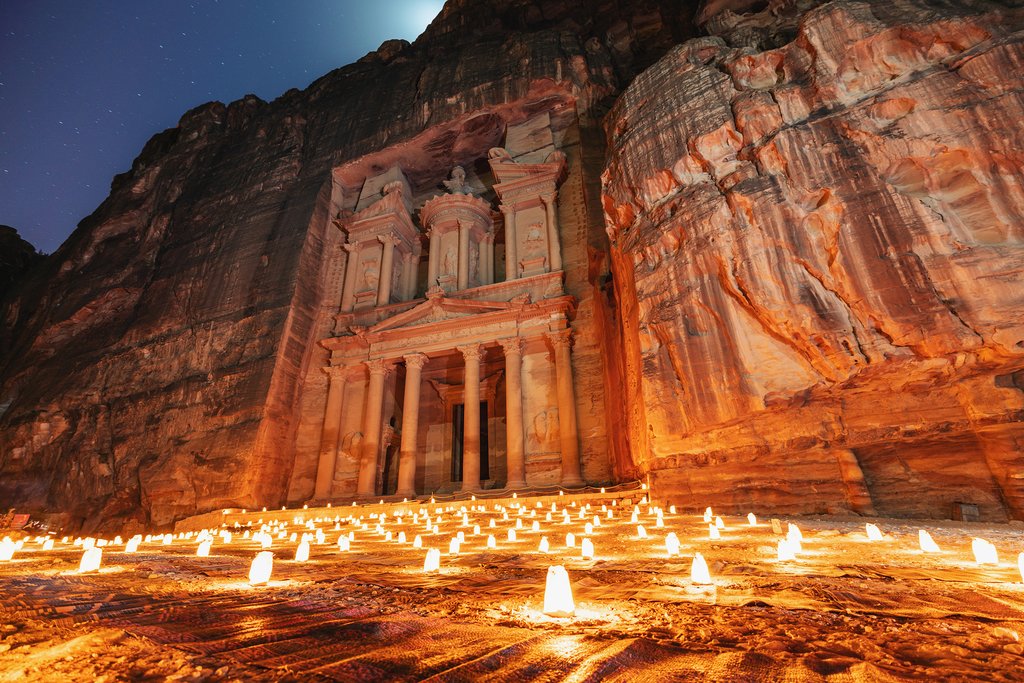Weather
July is, with August, the hottest month of the year. The daily high averages 91°F (33°C), but temperatures can often exceed 105°F (40°C), with the sun searing down for more than 14 hours a day and nary a cloud in the sky.
Fortunately, the summer air is dry and can still be comfortable. Pack a lightweight, loose-fitting wardrobe that protects against the sun; bring your shade hat, sunscreen, sunglasses; and be sure to drink lots of water. This is a month to start your Petra exploration as early as possible to take advantage of the lower temperatures. If you’re traveling with children (or older people), July may prove to be unbearably hot.
For more on weather this month, see Jordan in July: Travel Tips, Weather, and More.
Crowds & Costs
Most international visitors skip Jordan in mid-summer. Hence, Petra can now be enjoyed in relative solitude without the tour-bus hordes, and you can savor the solitude of the desert on a more personal level.
As this is the low season, airfares also come down, hotels decrease their rates, and many local excursions and tour packages are also bargain-priced. Although prices are now at their best, note that some restaurants and other places that rely on the tourist trade may close or operate at reduced hours for the low season.
Chat with a local specialist who can help organize your trip.
What to Do
July is a fantastic time to be in the desert at night. Away from the lights of Wadi Musa, the crystal-clear sky is so unbelievably dark you’ll gasp at the Milky Way galaxy and its billions of stars, made more humbling by the absolute desert silence. In July and August, you can see the prolific Perseids Meteor Shower streak across the sky. Unless there’s a bright moon, expect to see dozens of fireballs per hour as space debris ejected by the comet Swift-Tuttle fall to earth and burn up in the atmosphere.
For the best viewings, visit the Sky Gate Observatory, in nearby Wadi Rum (a 90-minute drive). With no lights and no pollution, this is the ideal spot to “Ooh!” and “Aah!” at the meteor shower, and astronomy experts are on hand. Plan on overnighting and enjoying the many activities at Wadi Rum.
Petra (which is hotter than Hades, yet otherwise perfectly fine to visit, in July and August) is not just about the sensational ruins. There are many other activities to do in the area that are not weather dependent, such as the Petra Museum and a superb dining scene. For a taste of the latter, prepare your own meal under the tutelage of professional chefs at Petra Kitchen, in Wadi Musa. It offers nightly classes, plus a multi-night cooking course that includes food sourcing at local markets.
In July, the desert can be stiflingly hot in the afternoon. Come as early as possible (the park opens at 6 am) to make the most of the cooler early morning hours. The Basin Restaurant and Coffee Shop, at the far end of the Colonnaded Street, are cool places to sit out the hotter hours before setting out on the steep climb to the Monastery for sunset. Be sure to drink plenty of water.
July Events
Eid al-Adha: The “Festival of Sacrifice” holiday commemorates the sacrifice that Ibrahim made to demonstrate obedience to God and is celebrated with feasts and acts of charity.
More helpful information
Petra in June
Petra in August
Ultimate Guide to Visiting Petra
Best Places to Stay Near Petra
